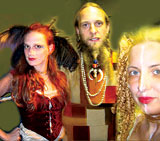
Rasputina appears to have cornered the market on dark cello rock played in gothy Victorian fashions.
|
There was a time when a cello in a rock arrangement was practically a novelty. A cello may have provided the beating heart of the Beatles’ “Eleanor Rigby,” and iconoclasts like Eno, Nick Drake, David Bowie and John Cale may have occasionally featured it, but the classical instrument was a foreigner in the world of rock ‘n’ roll.
No longer. From the drums-and-cello duo Talkdemonic and post-rock chamber textures of Rachel’s, to the country-inflected sounds of Alejandro Escovedo, Calexico and Norfolk & Western, and the Eastern European flavors of Nick Cave, Tom Waits and the Decemberists, the cello has become a favorite accent for many rock musicians.
But for Melora Creager and her group Rasputina, the cello isn’t an accent — everything else is. Formed in 1992 and originally called the Traveling Ladies’ Cello Society, Rasputina was the brainchild of Creager, who took up the instrument at the age of 9. Creager formed the all-cello trio after guest spots with bands on the 4AD label, including Ultra Vivid Scene, the Pixies and the Throwing Muses, later holding the cello seat on Nirvana’s final tour in 1994 (which included the televised recording of the band’s MTV Unplugged in New York). Those experiences persuaded her the cello could play a greater role in rock.
“I always got a really strong response to the cello, though I knew no one could hear it over the guitars,” Creager says by phone. “So I thought if you could actually hear the cello, if there were no guitars, just cellos, you’d get a really good response.”
And Rasputina did. Creager recruited fellow cellists Julie Kent and Agnieszka Rybska and created a unique brand of gothic chamber pop that interested the suits at Sony, who issued its debut, Thanks for the Ether, in 1996. The record was chockfull of dark tales inspired by some of history’s more tragic figures and events, including the Triangle Shirtwaist Factory fire of 1911, the doomed Donner Party, and reclusive billionaire weirdo Howard Hughes.
Adding to the odd, out-of-time sensation of hearing three classical cellos run through distortion pedals, Rasputina wore vintage Victorian costumes on stage, and Creager sang in an ethereal voice not far removed from Kate Bush’s wraith-like vocals. Creager also designed the band’s album art and merchandise, giving it a similar, Grimm Brothers-meet-Pre-Raphaelites feeling.
Creager says she initially built her songs around traditional classical motifs and transposed them to the verse-verse-chorus patter of rock. Despite her embrace by the college rock circuit, she was more inspired by the heavy bass lines of Nirvana, Black Sabbath and Led Zeppelin, which are more conducive to the cello’s deep timbre.
But writing rock songs on the cello proved no easy task. For one thing, you can’t play chords on one cello. But you can with three, and the more layers of cello you have, the more intricate chords you can create.
“Writing for cello isn’t like sculpting marble, where you take away,” Creager explains, “it’s more like clay, where you’re adding layers.”
The mix of classical instrumentation in a rock format earned Rasputina a base of curious fans, among them Goth rocker Marilyn Manson, who brought the band out on tour with him and remixed their song “Transylvanian Concubine.” But the band didn’t want to be pigeonholed like Apocalyptica (a Finnish all-cello group known for their remakes of Metallica songs), so Rasputina also toured with Bob Mould (Husker Du, Sugar), Porno for Pyros and most recently with Primus front man Les Claypool.
The band’s sophomore effort and last record for Sony, How We Quit the Forest, followed in 1998. The record turned up the band’s rock elements and highlighted Rasputina’s twisted sense of humor by combining references to the cartoon Space Ghost and De Beers diamond ads with serious songs about Rose Kennedy and Birkenau. Cabin Fever appeared on Moby’s label, Instinct, in 2002, as did their most recent studio release, 2004’s Frustration Plantation.
Considered by some to be Rasputina’s creative high point, Creager’s inspiration for Frustration Plantation came from her reading of George Washington Cable’s 19th-century historical fiction. Cable chronicled Creole life in Louisiana, and to match the record’s themes, Creager used the Library of Congress to research the region’s musical roots.
The loose conceptual nature of that record seems to have inspired Creager. Rasputina, now consisting of Creager, cellist Zoe Keating and drummer Jonathon TeBeest, have just finished their untitled next record, due out in early ’07. Based on what Creager calls a “cast recording that never was,” the new record imagines Mary Todd Lincoln as the Queen of Florida and includes hot-air balloon chases, with “a lot about Christian Fletcher and Mutiny on the Bounty” mixed in.
“I’ve been less inspired by other music than I have been by whatever I’m reading,” she says. “I read a lot of history, and it really gets my imagination going.”
[John Schacht is a freelance music writer.]
Rasputina plays The Grey Eagle (185 Clingman Ave.) with Aberdeen City on Sunday, Dec. 3. 9 p.m. $12/$15. 232-5800.


